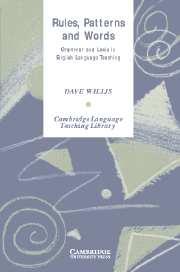Book contents
- Frontmatter
- Contents
- Acknowledgements
- 1 What is taught may not be what is learnt: Some preliminary questions
- 2 Grammar and lexis and learning
- 3 Developing a teaching strategy
- 4 The grammar of structure
- 5 The grammar of orientation: The verb phrase
- 6 Orientation: Organising information
- 7 Lexical phrases and patterns
- 8 Class: The interlevel
- 9 The grammar of spoken English
- 10 A final summary
- References
- Subject index
- Name index
4 - The grammar of structure
Published online by Cambridge University Press: 03 May 2010
- Frontmatter
- Contents
- Acknowledgements
- 1 What is taught may not be what is learnt: Some preliminary questions
- 2 Grammar and lexis and learning
- 3 Developing a teaching strategy
- 4 The grammar of structure
- 5 The grammar of orientation: The verb phrase
- 6 Orientation: Organising information
- 7 Lexical phrases and patterns
- 8 Class: The interlevel
- 9 The grammar of spoken English
- 10 A final summary
- References
- Subject index
- Name index
Summary
We established in Section 2.1 that structure refers to the way items – words and phrases – are sequenced to make up larger units. Words are built up to make phrases but, as we saw, the ordering is not random: the black cat is a possible ordering, cat the black is not. Words and phrases build up into clauses, but again the ordering is not random: I am studying grammar is possible, but Grammar am studying I is not. Clauses can be built up in turn to make sentences. In the text we looked at in Chapter 3 we found the following sentence: He gave me a 50p piece and as I gave him his change a man came in. This sentence is made up of three clauses:
He gave me a 50p piece.
I gave him his change.
A man came in.
Clauses 1 and 3 are joined by the conjunction and: He gave me a 50p coin and a man came in. Clause 2 is inserted between these two clauses, introduced by the subordinating conjunction as. So a sentence may be built up from two or more clauses. In this chapter we are concerned with the structure of these component clauses.
Clauses: Structure and pattern
In Section 2.1 I set out three rules which I claimed accounted for the structure of the English clause:
The basic structure of the clause is N + V +?. The continuation of the clause after the verb is determined by the meaning of the verb, not by abstract grammatical considerations.
[…]
Information
- Type
- Chapter
- Information
- Rules, Patterns and WordsGrammar and Lexis in English Language Teaching, pp. 69 - 93Publisher: Cambridge University PressPrint publication year: 2003
